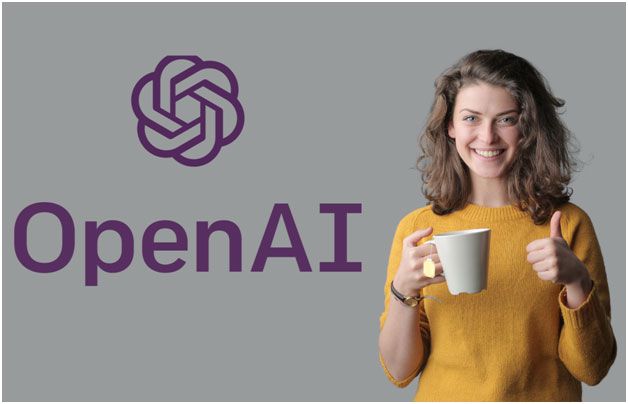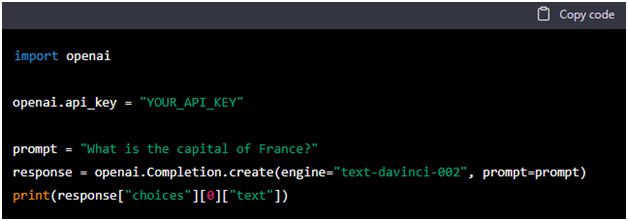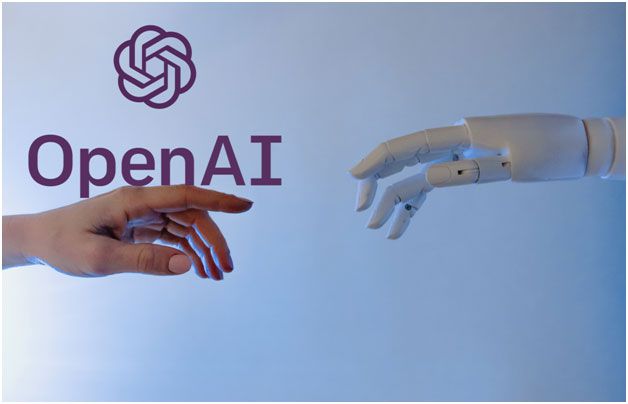What is Open AI?
OpenAI is a research organization that aims to promote and develop friendly AI in a responsible way. The organization was founded in December 2015 by a group of entrepreneurs and researchers, including Elon Musk, Sam Altman, and Ilya Sutskever.
OpenAI’s mission is to ensure that the benefits of AI are widely and equitably distributed. To achieve this goal, OpenAI conducts research in areas such as machine learning, robotics, and natural language processing, and makes its research and technology available to the public through open-source projects and partnerships.
One of OpenAI’s most notable contributions is the development of GPT-3 (Generative Pre-training Transformer 3), which is considered one of the most powerful natural language models yet. GPT-3 is trained on a massive dataset of text from the internet, and it can generate human-like text, answer questions, summarize information and more, it’s widely used in various industry and research fields.
OpenAI also provides access to its models through the OpenAI API, which allows developers to easily integrate its capabilities into their applications. Additionally, OpenAI provides tools, such as the OpenAI GPT-3 Playground, which is an interactive web-based interface that allows users to input prompts and see the model’s generated responses.
OpenAI is a research organization that aims to promote and develop friendly AI in a responsible way. It conducts research in areas such as machine learning, robotics, and natural language processing, and makes its research and technology available to the public through open-source projects and partnerships.

What is ChatGPT And How Can You Use It?
ChatGPT is a state-of-the-art language model developed by OpenAI. It is based on the GPT (Generative Pre-trained Transformer) architecture, which uses deep learning techniques to generate human-like text. ChatGPT can be used for a variety of natural language processing tasks, including answering questions, generating text, summarizing information, and more.
One of the key strengths of ChatGPT is its ability to generate highly coherent and fluent text. This makes it well-suited for tasks such as chatbot development, automated writing, and language translation. Additionally, ChatGPT can be fine-tuned to specific domains or tasks using smaller datasets. This allows it to generate more accurate and relevant responses.
ChatGPT can be accessed through the OpenAI API, which allows developers to easily integrate its capabilities into their applications. It also can be used through OpenAI’s GPT-3 Playground, which is an interactive web-based interface that allows users to input prompts and see the model’s generated responses.
Who Built ChatGPT?
ChatGPT is a language model developed by OpenAI, a research organization dedicated to creating and promoting friendly AI. The model was first introduced in 2019, as a successor to their previous model GPT-2.
The development of ChatGPT was led by a team of researchers and engineers at OpenAI, including Ilya Sutskever, who is now the co-founder and Chief Scientist at the organization. The team used a dataset of over 570GB of text from the internet, which was used to train the model’s neural network.
The initial version of ChatGPT was trained on a transformer architecture, which is a type of neural network that is particularly well-suited for natural language processing tasks. This architecture allows the model to understand and generate text in a way that mimics human language.
Over time, the team has fine-tuned and improved the model with more data and techniques, which has led to the release of GPT-3, which is considered as the most powerful natural language model yet, achieving high results in various NLP tasks.
OpenAI has made the model available to researchers and developers through the OpenAI API, making it easy to integrate its capabilities into various applications. Since its release, ChatGPT has been used in a wide range of applications, from chatbots to automated writing and more.
How to use Programmer ChatGPT?
Using ChatGPT as a programmer is relatively straightforward, as the model can be easily integrated into various applications through the OpenAI API. The first step in using ChatGPT is to obtain an API key from OpenAI, which will allow you to access the model’s capabilities.
Once you have an API key, you can use it to send requests to the API and receive responses from the model. The API can be accessed through a variety of programming languages, including Python, Java, and C#.
To use ChatGPT, you would typically send a prompt to the API, which is a piece of text that the model will use as a starting point to generate a response. The prompt can be a question, a statement, or any other type of text that you would like the model to generate text based on.
For example, in python, you can use the openai package to access the API, and use the Completion.create() method to send a prompt and receive a response.

This will print the answer “Paris” as the capital of France.
You can also fine-tune the model to specific domains or tasks by providing additional parameters in the API request, such as the model’s temperature, top_p and top_k. These parameters allows you to control the model’s level of creativity, the proportion of responses to keep, and the number of responses to generate.
Additionally, you can use the openai.Completion.create() method to specify more complex tasks like generating a full story, answer a question, summarize a text, and so on.
Overall, using ChatGPT as a programmer involves sending prompts to the API, and processing the responses returned by the model. With the help of the OpenAI API, developers can easily integrate the model’s capabilities into a wide range of applications and benefit from its advanced natural language understanding and generation capabilities.
How Was ChatGPT Trained?
ChatGPT, a state-of-the-art language model developed by OpenAI, was trained using a deep learning technique called unsupervised learning. This technique involves training the model on a large dataset of text without providing explicit labels or annotations. The model learns to understand and generate text by analyzing patterns and relationships within the data.
The training dataset used for ChatGPT consists of a diverse set of texts from the internet, including books, articles, and websites. The dataset is preprocessed to remove any personal information and noise, then tokenized and indexed, which means breaking the text into smaller units, called tokens and assigning a unique numerical value to each token.
The model is trained on this dataset using a transformer architecture, which is a type of neural network that is particularly well-suited for natural language processing tasks. The transformer architecture allows the model to understand and generate text in a way that mimics human language.
During the training process, the model is presented with a sequence of tokens from the dataset and is trained to predict the next token in the sequence. By repeatedly making predictions and adjusting its internal parameters, the model learns to understand and generate text in a way that mimics human language.
The training process is computationally intensive and requires a lot of computational resources and time, but once it’s done, the model can be fine-tuned to specific domains or tasks by providing additional data and adjusting the parameters.
ChatGPT was trained using unsupervised learning on a large dataset of diverse texts from the internet. The training process involved using a transformer architecture and repeatedly making predictions and adjusting the model’s internal parameters to learn to understand and generate text in a way that mimics human language. The model is fine-tuned to specific tasks or domains by providing additional data and adjusting parameters.

What are the Limitations of ChatGPT?
hatGPT, like any other language model, has a few limitations that should be considered when using it for natural language processing tasks. Here are a few of the main limitations of ChatGPT:
- Lack of commonsense: ChatGPT, like other language models, is trained on a large dataset of text from the internet. However, it lacks the ability to understand and reason about the real-world concepts and commonsense knowledge that humans possess. This can lead to the model generating responses that are not entirely appropriate or realistic.
- Bias: The model is trained on a dataset of text from the internet, which can contain biases and stereotypes. Therefore, the model can inherit these biases and generate responses that are not inclusive or sensitive to certain groups of people.
- Limited context understanding: ChatGPT is a language model, which means it can generate text based on the input prompt, but it may not always be able to fully understand the context of the conversation, leading to irrelevant or generic responses.
- Reliance on the data: ChatGPT is only as good as the data it has been trained on. Therefore, it can be limited in its understanding of certain domains or tasks if the training data is not representative of these domains.
- Computational resources: The model requires a significant amount of computational resources to run and can be costly to use at scale.
- Lack of control over the output: Although the model’s temperature, top_p and top_k parameters can be adjusted to control the model’s level of creativity, it’s still difficult to control the specific responses the model generates.
ChatGPT is a powerful tool for natural language processing, but it has some limitations. The model lacks commonsense, may contain biases, can have limited context understanding, and is reliant on the data it has been trained on. Additionally, it requires significant computational resources and it’s difficult to control the specific responses the model generates
How to use ChatGPT
There are several ways to use ChatGPT, depending on your specific use case. Here are a few examples:
- Chatbot development: ChatGPT can be used to develop chatbots that can understand and respond to natural language input. The model can be fine-tuned to a specific domain or task, such as customer service or e-commerce, to generate more accurate and relevant responses.
- Automated writing: ChatGPT can be used to generate text for a wide range of applications, such as content creation, news articles, and social media posts. The model can be fine-tuned to specific styles or topics, such as poetry or sports, to generate more coherent and fluent text.
- Language translation: ChatGPT can be fine-tuned to understand and generate text in multiple languages, making it well-suited for language translation tasks.
- Question answering: ChatGPT can be fine-tuned to answer questions based on a specific domain or task, such as customer service or technical support, to generate more accurate and relevant responses.
- Summarization: ChatGPT can be fine-tuned to summarize a given text, it can extract the main ideas and convert it into a shorter version.
To use ChatGPT, you typically need to have an API key from OpenAI, which will allow you to access the model’s capabilities. You also need to have a programming language, such as python, that can send requests to the API, process the response and generate the output. Additionally, you can use GPT-3 Playground, which is an interactive web-based interface that allows users to input prompts and see the model’s generated responses. This can be useful for testing the model, fine-tuning it, or for non-technical users that want to use the model’s capabilities.

Reblog It collaborates closely with clients to develop tailored guest posting strategies that align with their unique goals and target audiences. Their commitment to delivering high-quality, niche-specific content ensures that each guest post not only meets but exceeds the expectations of both clients and the hosting platforms. Connect with us on social media for the latest updates on guest posting trends, outreach strategies, and digital marketing tips. For any types of guest posting services, contact us on reblogit.webmail[at]gmail.com.
